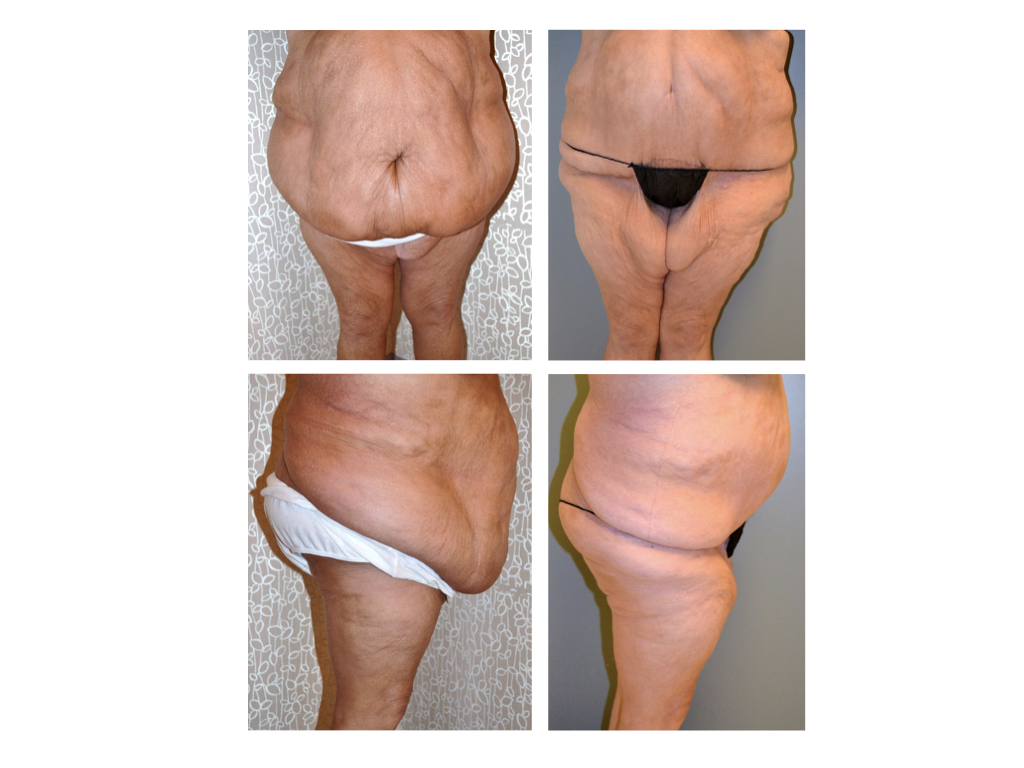
The best procedure for you will depend on your body, your overall health, previous surgeries, and your desired aesthetic and functional outcomes. It’s important to have a clear goal and understand your options before considering either operation. In the case of panniculectomy, if there is a lot of residual weight patients may experience delayed wound closure and a resulting scar. More rarely, these procedures can lead to localized numbness, deep vein thrombosis, or persistent pain. While these procedures are very common and the risks are low, any surgical procedure carries the risk of scar formation, infection, and body fluids collecting at the site of the operation. This can often be repaired at the same time as a panniculectomy or tummy tuck and may be covered by insurance, although it’s unlikely to change the cost of the procedure significantly. Some patients may develop a hernia, which occurs when tissue protrudes through a weakening in one of the muscle walls that enclose the abdominal cavity.
#PANNICULECTOMY VS TUMMY TUCK SKIN#
Your insurance will sometimes cover a panniculectomy for health reasons if the pannus results in skin rashes and interferes with your daily activities. RELATED: The Dos and Don’ts of Exercising After a Tummy Tuck Does Insurance Cover Panniculectomy Surgery? In essence, an abdominoplasty is a cosmetic procedure for the upper and lower abdomen, whereas a panniculectomy is a functional procedure for the lower abdomen that focuses on excising the abdominal apron. Because there is usually a significant amount of excess tissue, a vertical incision may also be performed. Sometimes liposuction is also performed on the flanks, along with other minor aesthetic revisions that your surgeon will discuss with you in advance.ĭuring panniculectomy surgery, similar techniques are employed to address the excess skin and fat layers in the lower abdomen area, without repairing any muscle separation.

Excess skin is removed, the belly button is repositioned, and the skin is pulled taught and sutured. The skin is detached from the abdominal wall, giving access to the tissue underneath, which is tightened using sutures. Is often performed along with other body contouring procedures.ĭuring abdominoplasty surgery in Paramus, incisions are made above the panty-line and around the belly button.Focuses on the pannus, an apron-like flap of skin and fat in the lower abdomen area that can hang down over the groin.Is considered a functional procedure, as it improves mobility and addresses skin concerns caused by chafing.In many cases, liposuction is also performed to eliminate excess belly fat.Addresses excess skin in the upper and/or lower abdominal area, as well as weakened or separated abdominal muscles.Is mainly performed for cosmetic reasons, to attain a more flattened abdomen.There is no impact on weakened or separated muscles in the abdominal wall. While these two procedures are in many ways similar, a panniculectomy only removes excess, hanging skin. This skin does not provides any structural support, and can become stretched after pregnancy or significant weight loss.Ībdominoplasty and Panniculectomy: Key Differences Skin drapes the abdomen, and molds to the underlying fat.While most of us have a small pouch there, sometimes there can be very large fat deposits in this area that sag down over the groin. Subcutaneous fat is stored on the outside of the abdominal wall.

These structures may become lax over time, or disrupted by surgery, a hernia, or trauma.

There are three basic structures involved in procedures on the lower abdomen. Breslow of The Breslow Center for Plastic Surgery in Paramus, New Jersey discuss the main differences between these two approaches.

The right procedure for you will depend on your treatment goals and body type. A panniculectomy, also known as apron surgery, focuses more specifically on removing fat and skin that hangs down over the genitals and thighs, typically after massive weight loss. An abdominoplasty, also known as a tummy tuck, gives the abdomen a more toned appearance by tightening the abdominal muscles and removing excess skin or fat.


 0 kommentar(er)
0 kommentar(er)
